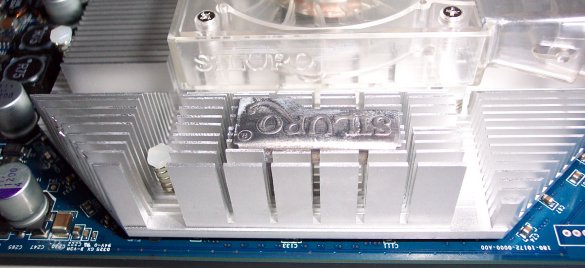Card appearance
ABIT have made noises (no pun intended) about just how quiet and effective its OTES cooling system has now become. We first saw the OTES (Outside Thermal Exhaust System) cooling incorporated into a special GeForce4 Ti 4200 card. That card, however was more noted for its extremely high sound levels, much to ABIT's dismay. The OTES revolution is now firmly incorporated into ABIT's range. This one promises to be quiet and effective ... a mutually exclusive solution ?.

Let's remember that this is a regular GeForce FX5900 video card. MSI, ASUS and Gainward's interpretations have passed through Hexus and each card was a toned, single-slot card. ABIT stick with a double height card that's almost exclusively used for the Ultra model. ABIT will no doubt claim that its extravagant cooling warrants the use of a PCIslot; we're not so sure. As with every other hungry GPU doing the reviewing rounds this one needs an auxillary power connector, all fed via a standard MOLEX plug.

The heatsink employed on the OTES FX5900 looks more potent that many a CPU heatsink's. A huge slab of aluminium graces both the GPU and RAM chips. As we often comment, having integrated cooling can be both a boon and disadvantage in equal terms. The GPU's heat is transferred to the heatsink and pushed out to the rear via the top-mounted fan and plastic 'tunnel'. In a nod towards aesthetics, ABIT decide to incorporate a few blue LEDs. It all look wonderful when in a windowed case.

Isn't that pretty ?. The massive heatsink does its level best to steal the show away from the illuminations.

The pipe that ferries the heat propelled by the fan is a little strange. The interlinked sections are free to move with a degree of freedom, and they seem to have an elastic feel. This seems like an exercise in form over function. It certainly does look good.

The back's received a little extra cooling treatment, too. A thick aluminium heatsink is placed on the back to help push away as much heat as possible. 128MB of 2.2ns Hynix memory is placed on the topside; we can clearly see the BGA positions from the rear. Had this been an FX5900 Ultra model we'd have seen another 128MB on the rear, too. A number of graphics card manufacturers have worked their cooling magic for FX5900 cards, and it's always nice to see individual-looking cards from those concerned. Looks are starting to play an increasingly important role in potential hardware sales, and this card is no ugly duckling.
Yet some may say we've glossed over the entire point of this OTES cooling system. It's reckoned to produce on 25dBA. The OTES FX5900 is a relatively quiet card in a system that produces a moderate amount of noise, but if you're looking for an ultra-quiet system this card still produces a hum that may fray a few nerves. It's far from loud and we congratulate ABIT on bringing FX5900 power without having to don a pair of ear defenders. This is the kind of cooling and relative quietness that'll find itself being specified in high-end OEM systems. Quiet but no Zalman.

A steady stream of warmish air flows through the vent residing on the second slot plate. The usual DVI, HD15 and video-out connections are found on the lower plate. This particular model features only TV-Out (1024x768 max) through a Philips chip, so home movie buffs may need to look elsewhere to fulfill their editing requirements. This card arrived with just a CD-R keeping it company. Evidently, ABIT are finalising the packaging. Expect to find a CD containing drivers, DirectX9, ABIT MAX overclocking utility, Soldier of Fortune II demo, Earthviewer 3D demo, Windows Blinds, and a bunch of cables helping the card's TV-Out ability. We'll report back once we have a full retail sample.









